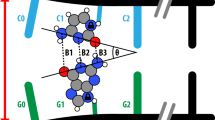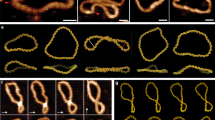Abstract
The two intertwined strands of DNA are held together through base pairing—the formation of hydrogen bonds between bases located opposite each other on the two strands. DNA replication and transcription involve the breaking and re-forming of these hydrogen bonds, but it is difficult to probe these processes directly. For example, conventional DNA spectroscopy1,2,3 is dominated by solvent interactions, crystal modes and collective modes of the DNA backbone; gas-phase studies, in contrast, can in principle measure interactions between individual molecules in the absence of external effects, but require the vaporization of the interacting species without thermal degradation4,5,6,7,8,9. Here we report the generation of gas-phase complexes comprising paired bases, and the spectroscopic characterization of the hydrogen bonding in isolated guanine–cytosine (G–C) and guanine–guanine (G–G) base pairs. We find that the gas-phase G–C base pair adopts a single configuration, which may be Watson–Crick, whereas G–G exists in two different configurations, and we see evidence for proton transfer in the G–C pair, an important step in radiation-induced DNA damage pathways10. Interactions between different bases and between bases and water molecules can also be characterized by our approach, providing stringent tests for high-level ab initio computations that aim to elucidate the fundamental aspects of nucleotide interactions11,12,13.
This is a preview of subscription content, access via your institution
Access options
Subscribe to this journal
Receive 51 print issues and online access
$199.00 per year
only $3.90 per issue
Buy this article
- Purchase on Springer Link
- Instant access to full article PDF
Prices may be subject to local taxes which are calculated during checkout

Similar content being viewed by others
References
Fodor, S. P. et al. H/Sub 2/Raman-shifted YAG laser ultraviolet raman spectrometer operating at wavelengths down to 184 nm. J. Raman Spectrosc. 17, 471–475 (1986).
Urabe, H. et al. Collective vibrational modes in molecular assembly of DNA and its application to biological systems. Low frequency raman spectroscopy. J. Chem. Phys. 82, 531–535 (1985).
Cocco, S. & Monasson, R. Theoretical study of collective modes in DNA at ambient temperature. J. Chem. Phys. 112, 10017–10033 (2000).
Brady, B. B., Peteanu, L. A. & Levy, D. H. The electronic spectra of the pyrimidine bases uracil and thymine in a supersonic molecular beam. Chem. Phys. Lett. 147, 538–543 (1988).
Viant, M. R. et al. Infrared laser spectroscopy of uracil in a pulsed slit jet. J. Chem. Phys. 103, 9502– 9505 (1995).
Nir, E. et al. REMPI spectroscopy of jet cooled guanine. J. Am. Chem. Soc. 121, 4896–4897 ( 1999).
Yanson, I. K., Teplitsky, A. B. & Sukhodub, L. F. Molecular interactions in nucleic acids. Biopolymers 18, 1149–1170 (1997).
Dey, M. et al. Base pair formation of free nucleobases and mononucleosides in the gas phase. J. Am. Chem. Soc. 116, 9211 –9215 (1994).
Dey, M., Grotemeyer, J. & Schlag, E. W. Pair formation of free nucleobases and mononucleosides in the gas-phase. Z. Naturforsch. 49A, 776 –784 (1994).
Hutter, M. & Clark, T. On the enhanced stability of the guanine-cytosine base-pair radical cation. J. Am. Chem. Soc. 118, 7574–7577 (1996).
Florian, J., Leszczynski, J., Johnson, B. G. On the intermolecular vibrational modes of the guanine-cytosine, adenine-thymine and formamide-formamide H-bonded dimers. J. Mol. Struct. 349, 421–426 ( 1995).
Shishkin, O., Sponer, J., Hobza, P. Intermolecular flexibility of DNA bases in adenine-thymine and guanine-cytosine Watson-Crick base pairs. J. Mol. Struct. 477, 15–21 (1999).
Santamaria, R. et al. Vibrational spectra of nucleic acid bases and their Watson-Crick pair complexes. J. Comput. Chem. 20, 511 –530 (1999).
Meijer, G. et al. Laser desorption jet-cooling of organic molecules. Cooling characteristics and detection sensitivity. Appl. Phys. B 51, 395–403 (1990).
Schutz, M., Burgi, T. & Leutwyler, S. Intermolecular bonding and vibrations of phenol.H 2O (D2O). J. Chem. Phys. 98, 3763–3777 (1993).
Schmitt, M., Jacoby, C. & Kleinermanns, K. Torsional splitting of the intermolecular vibrations of phenol (H2O)1 and its deuterated isotopomers. J. Chem. Phys. 108, 4486–4495 (1997).
Sponer, J., Leszczynski, J. & Hobza, P. Structures and energies of hydrogen-bonded DNA base pairs. A nonempirical study with inclusion of electron correlation. J. Phys. Chem. 100, 1965–1974 (1995).
Hobza, P. et al. Performance of empirical potentials (AMBER, CFF95, CVFF, CHARMM, OPLS, POLTEV), semiempirical quantum chemical methods (AM1, MNDO/M, PM3), and ab initio Hartree-Fock method for interaction of DNA bases: Comparison with nonempirical beyond Hartree-Fock results. J. Comput. Chem. 18, 1136–1150 ( 1997).
Hobza, P. & Sponer, J. Thermodynamic characteristics for the formation of H-bonded DNA base pairs. Chem. Phys. Lett. 261, 379–384 (1996).
Colson, A. et al. Ab initio molecular orbital calculations on DNA base pair radical ions: Effect of base pairing on proton-transfer energies, electron affinities, and ionization potentials. J. Phys. Chem. 96, 9787–9794 (1992).
Janzen, C. et al. Structure and vibrations of Phenol(H2O)7,8 studied by infrared-ultraviolet and ultraviolet-ultraviolet double-resonance spectroscopy and ab initio theory. J. Chem. Phys. 110, 9898–9907 (1999).
Acknowledgements
This work has been supported by the Deutsche Forschungsgemeinschaft and United States–Israel Binational Science Foundation.
Author information
Authors and Affiliations
Corresponding author
Supplementary information
Rights and permissions
About this article
Cite this article
Nir, E., Kleinermanns, K. & de Vries, M. Pairing of isolated nucleic-acid bases in the absence of the DNA backbone . Nature 408, 949–951 (2000). https://doi.org/10.1038/35050053
Received:
Accepted:
Issue Date:
DOI: https://doi.org/10.1038/35050053
This article is cited by
-
Unravelling molecular interactions in uracil clusters by XPS measurements assisted by ab initio and tight-binding simulations
Scientific Reports (2020)
-
Characterization of thymine microcrystals by CARS and SHG microscopy
Scientific Reports (2020)
-
Exploring Hydrogen Bond in Biological Molecules
Journal of the Indian Institute of Science (2020)
-
Simulated NIR spectra as sensitive markers of the structure and interactions in nucleobases
Scientific Reports (2019)
-
Theoretical study on the substituent effect of halogen atom at different position of 7-azaindole-water derivatives: relative stability and excited-state proton-transfer mechanism
Structural Chemistry (2018)
Comments
By submitting a comment you agree to abide by our Terms and Community Guidelines. If you find something abusive or that does not comply with our terms or guidelines please flag it as inappropriate.



